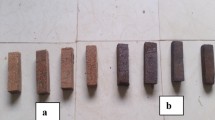Abstract
The aim of this study was to develop, manufacture and determine properties of veneer overlaid flat pressed wood plastic composite (WPC) panels from recycled low density polyethylene (rLDPE), wood particles and different kinds of veneer (rotary-cut birch veneer and sliced oak veneer) using various adhesives by one-step hot pressing. Food packaging polyethylene film (PE film) as recycled stretch wraps, recycled low density polyethylene (rLDPE) particles and phenol formaldehyde (PF) resin were applied as adhesive for the bonding of veneer to the surface of WPC. No modification additives were used for the manufacture of WPC. It was found that compared with non-veneered WPC, the panels sandwiched with natural veneers greatly improved their properties. The bending strength was improved in 1.9–2.6 and 7.9–10 times across and along veneer fibers respectively for both types of investigated veneer. The highest values of bending strength were observed in WPC panels veneered with rotary-cut birch veneer. However, the water resistance of veneered WPC panels was reduced in comparison with non-veneered. The WPC specimens veneered with both types of veneer using PE film had better mechanical properties and water resistance than those of the specimens made with other two types of adhesives. The veneering of WPC panels enables to significantly improve adhesion properties of these veneered surfaces for their further finishing. In addition, the veneering of WPC panels hides the surface defects and provides a uniform application of different paints, varnishes and films to the surface of such materials. Overlaying WPC panels with wood veneers improves their appearance and properties resulting in eco-friendly value-added products.



Similar content being viewed by others
References
Niska K, Sain M (2008) Wood-polymer composites. Woodhead publishing limited, Cambridge
Ibach R, Clemons C (2006) Effect of acetylated wood flour or coupling agent on moisture, UV and biological resistance of extruded woodfiber-plastic composites. Wood Protection 2006: New Orleans, Louisiana, WI: Forest Products Society, Madison, 2006:139–147
H’ng P, Lee A, Meng H (2008) J Eng Appl Sci 3(5):13–19
Ayrilmis N, Jarusombuti S (2011) J Compos Mater 45:103–112
Benthien JT, Thoemen H (2012) Compos Part A 43(3):570–576
Ayrilmis N, Benthien J, Thoemen H, White R (2012) Eur J Wood Wood Prod 70:215–224
Lyutyy P, Bekhta P, Sedliacik J, Ortynska G (2014) Acta Facultatis Xylologiae Zvolen 56(1):39–50
Bekhta P, Lyutyy P, Ortynska G (2016) Drvna Ind 67(2):113–118
Schmidt H, Benthien J, Thoemen H (2013) Eur J Wood Wood Prod 71:591–597
Jarusombuti S, Ayrilmis N (2011) Eur J Wood Wood Prod 69:375–382
Chaharmahali M, Mirbagheri J, Tajvidi M, Najafi SK, Mirbagheri Y (2010) J Reinf Plast Compos 29(2):310–319
Wechsler A, Hiziroglu S (2007) Build Environ 42:2637–2644
Jiang L, Wolcott MP, Zhang JW, Englund K (2007) Polym Eng Sci 47(3):281–288
Ayrilmis N, Benthien JT, Thoemen H (2012) Compos Part B 43:325–331
Vos D (1998) The engineering properties of woodfiber–plastic panels. MS thesis, Department of Civil and Environmental Engineering. University of Wisconsin, Madison
Pecina H, Kuhne G, Stephan JP (1998) Holz Roh Werkst 56:114
Falk RH, Vos DJ, Cramer SM (1999) The comparative performance of woodfiber-plastic and wood based panels. In: Rowell R (ed) 5th International Conference on Woodfiber-Plastic-Composites, Madison, 269–274
Shibata M, Takachiyo K, Ozawa K, Yosomiya R, Takeishi H (2002) J Appl Polym Sci 85:129–138
Rizvi GM, Semeralul H (2008) J Vinyl Add Tech 14(1):39–42
Ayrilmis N, Jarusombuti S, Fueangvivat V, Bauchongkol P (2011) Polym Degrad Stabil 96:818–822
Norvydas V, Minelga D (2006) Mater Sci (Medžiagotyra) 12(4):328–332
Istek A, Aydemir D, Aksu S (2010) BioResources 5(2):1074–1083
Borysiuk P, Zbiec M, Boruszewski P, Maminski M, Mazurek A (2011) Ann Wars Univ Life Sci SGGW For Wood Technol 73:172–175
Lyutyy P, Bekhta P, Ortynska G, Sedliačik J (2017) Acta Facultatis Xylologiae Zvolen 59(1):(under review)
EN 323 (1992) Wood-based panels–determination of density. European Committee for Standardization, Brussels
EN 312 (2003) Particleboards–specifications. European Committee for Standardization, Brussels
EN 322 (1992) Wood-based panels–determination of moisture content. European Committee for Standardization, Brussels
EN 310 (1993) Wood-based panels–determination of modulus of elasticity in bending and of bending strength. European Committee for Standardization, Brussels
EN 317 (1993) Particleboards and fibreboards–determination of swelling in thickness after immersion in water. European Committee for Standardization, Brussels
Green D, Winandy J, Kretschmann D (1999) Mechanical properties of wood. Chapter 4. In: Wood handbook—Wood as an engineering material, General Technical Report FPL-GTR-190. Madison
Clemons C (2002) For Prod J 52(6):10–18
Adhikary KB, Pang S, Staiger MP (2008) Compos Part B 39:807–815
Chen HC, Chen TY, Hsu CH (2006) Holz Roh Werkst 64:172–177
Gramlich W, Gardner D, Neivandt D (2006) J Adhes Sci Technol 20:1873–1887
Garbassi F, Morra M, Occhiello E (1994) Polymer Surfaces: from physics to technology. Wiley, New York
Dunky M (2003) Adhesives in the Wood Industry. Chapter 47. Handbook of Adhesive Technology. Marcel Dekker, New York
EN 300 (2006) Oriented Strand Boards (OSB)—definitions, classification and specifications. European Committee for Standardization, Brussels
ISO 13894-2 (2005) High-pressure decorative laminates—composite elements—Part 2: specifications for composite elements with wood-based substrates for interior use
Acknowledgements
The authors are grateful to the Slovak Academic Information Agency (SAIA) for financial support of this study.
Author information
Authors and Affiliations
Corresponding author
Rights and permissions
About this article
Cite this article
Bekhta, P., Lyutyy, P. & Ortynska, G. Properties of Veneered Flat Pressed Wood Plastic Composites by One-Step Process Pressing. J Polym Environ 25, 1288–1295 (2017). https://doi.org/10.1007/s10924-016-0904-2
Published:
Issue Date:
DOI: https://doi.org/10.1007/s10924-016-0904-2




